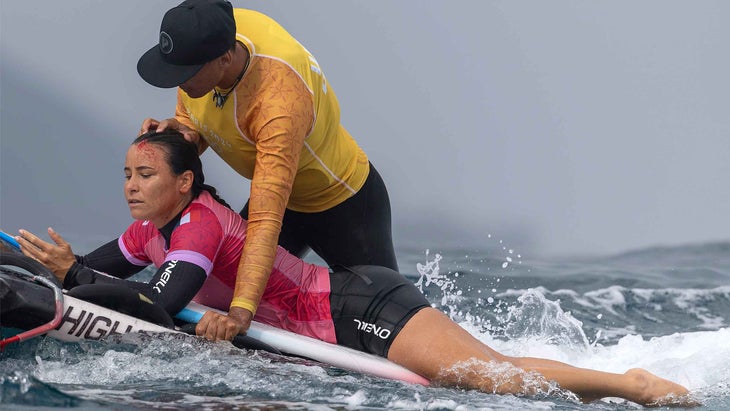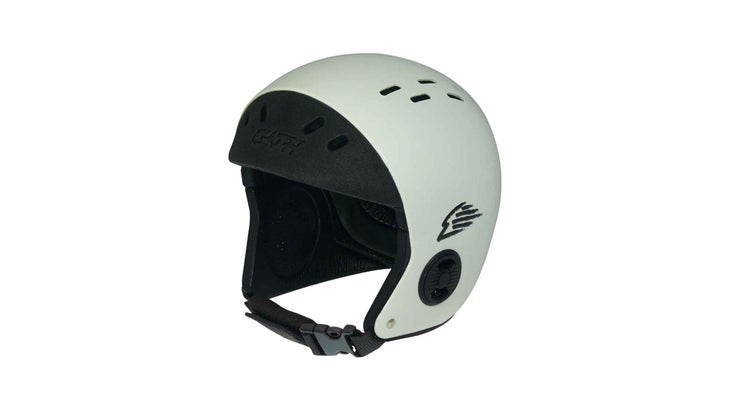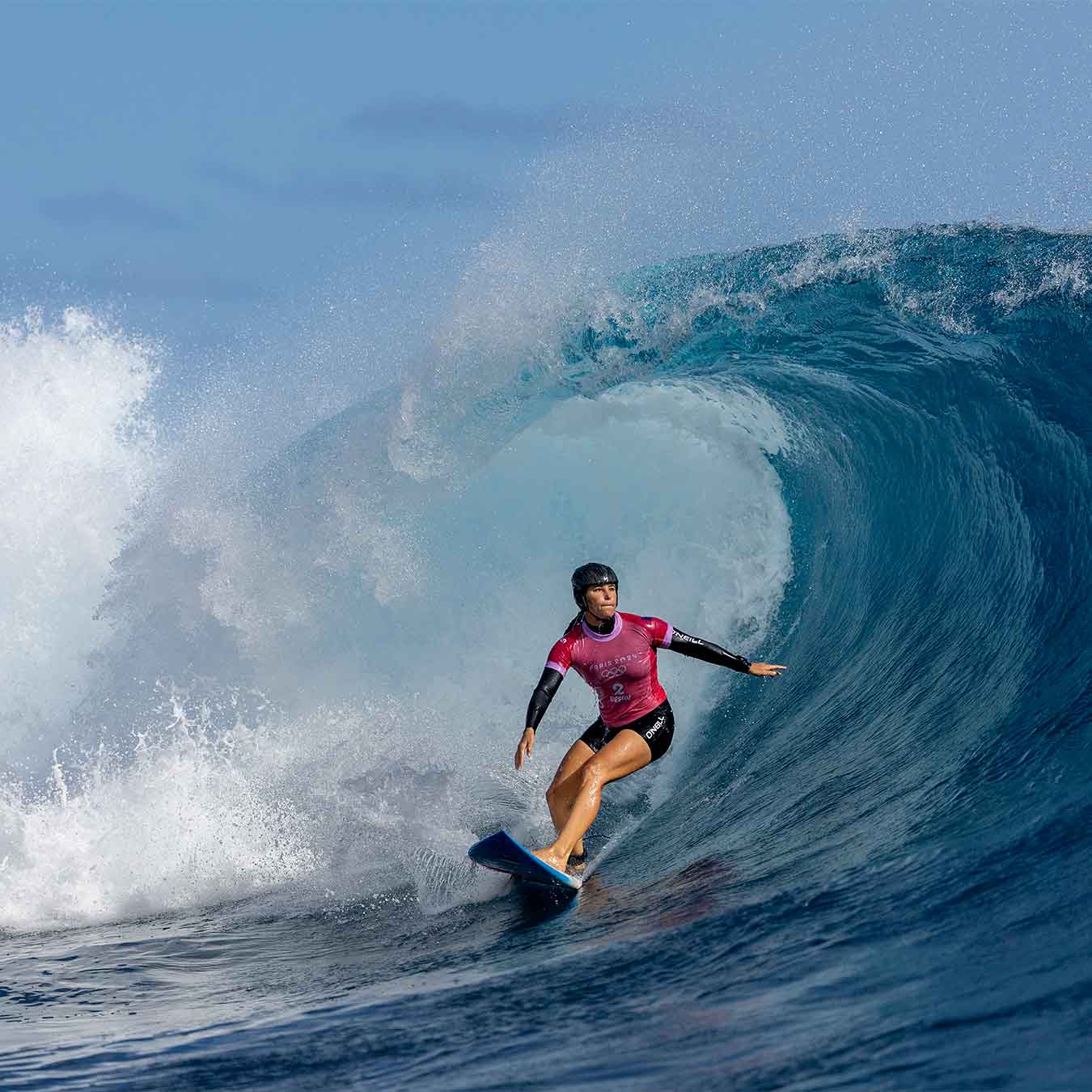In its 2021 Olympic debut in Japan, surfing took place at a nice little beach break, and it made for a fun watch. 2024 has been an entirely different animal. Held at Tahiti’s infamous Teahupoʻo, a storm brought thick, house-sized barrels detonating onto razor-sharp coral reef while the world’s best surfers deliberately put themselves in harm’s way in the quest for gold. But medals weren’t the only hardware on display.
If you’ve been watching the competition, this is likely the first time you’ve seen surfers wearing helmets. Even if you spend a lot of time at the beach, you’ve probably never seen them on surfers before. In round one of the Olympic surf competition, a whopping 17 out of 24 female surfers wore a helmet, and five of the men did, too.
We didn’t have to wait long to see why helmets were so popular. Early in the contest, France’s started without a helmet, then wiped out on her first wave and went headfirst into the reef, splitting her forehead open. She immediately requested a helmet, which staff delivered to her via jet ski and put onto her still-bleeding head. She would later require four stitches, but she was extremely lucky that the impact wasn’t worse. Not everybody has been so fortunate recently.
Check out our coverage of the winning mountain bikes and the at the 2024 Paris Olympics.

A Brief Helmet History
I reached out to team (Lenny is arguably the best big wave surfer in the world), who has some experience with this subject. Earlier this year Lenny went down on a seemingly innocuous wave at Oahu’s famous Pipeline. It was one of the first times he wore a helmet surfing, but something that morning told him it was a good idea. He ended up driven into the reef with so much force that the impact split his helmet in half. Lenny was somehow able to get himself to shore, but he was badly concussed, and has virtually no memory of the incident. He spent months recovering and dealing with all of the nightmarish brain-injury symptoms you hear about from NFL players. It’s almost certain that and the debate about wearing a surf helmet has picked up since then.
That said, surf helmets aren’t actually all that new. Surfers have been wearing them at hard-bottom breaks since at least the early ‘90s. Australia’s Tom Carroll famously wore a helmet during his dominant performance at the 1991 Pipeline Masters contest. Takayuki Wakita, Naohisa Ogawa, and Atsushi Imamura were a trio of legendary Japanese chargers who all donned helmets. Even more recently, France’s Jeremey Flores and Australia’s Owen Wright each won first place while wearing helmets in the Tahiti Pro (also held at Teahupoʻo) in 2015 and 2019, respectively. So, surf helmet use is by no means unprecedented, but it’s never been common, which is why seeing nearly half of the surfers at the Olympics feels like something of a sea change moment.
 The Gath Eva Hat helmet ($169) (Photo: Courtesy Gath)
The Gath Eva Hat helmet ($169) (Photo: Courtesy Gath)
Anatomy of a Surf Helmet
Broadly speaking, there are two types of surf helmets: Soft and hard-shell. As the name suggests, hard helmets have a plastic shell on the outside with a layer (or multiple layers) of foam underneath. These are more akin to bike helmets and ski/snowboard helmets. Most are uniform round shells for less drag in the water, with significant ports around the ears to prevent water from accumulating there. The soft helmets look a bit more like something you’d see in a martial arts competition. While they’re lighter and more comfortable, they also don’t offer quite as much protection. As far as I could tell, everybody in the Olympics contest was wearing variations of the hard-shell design.
The three biggest players in the surf helmet game are and hard shells, and . Gath helmets look not-unlike bowling balls, with bits of ventilation here and there, and they typically go for $170-$190, depending on the model. They offer solid protection for the top, back, and sides of your head. Simba helmets go a bit further, with helmets that stretch downward from the sides to cover more of the sensitive jawline, which gives them more of an intense gladiator look. They go for about $200. ($79) offers the least protection, but it’s made with a soft, non-absorbent foam to keep it from getting waterlogged. It’s also the lightest and one of the cheapest options.
There are other brands that make surf helmets as well, and it’s not unusual to see kayak-helmets used for surf. Kai Lenny is now developing his own surf helmet, which will have carbon fiber. Like bike helmets, plastic surf helmets are actually designed to break on impact to help diffuse the energy of the blow. Carbon fiber breaks, too, but as it does it distributes the force more evenly around the entire shell, theoretically decreasing the energy transferred to your skull and brain. There’s no word yet on the timing of its release or how much it will cost.
Some Olympians, like Defay, were wearing what appeared to be bike helmets in the lineup, with cutouts all over them for ventilation and drainage. They had some ear coverage, too, so I don’t believe they were literally bike helmets, but the point is any protection may be better than nothing if you’re heading into some heavy water.
To Wear or Not to Wear?
There are a few reasons helmets aren’t ubiquitous at the beach, though. While it’s universal that it’s preferable to have a helmet on if you’re going to hit a hard object such as a reef, a rock, a surfboard, or even a hard-packed sand bottom, those are still thankfully rare occasions. What you are almost guaranteed to encounter in every surf session, however, is turbulence when duck-diving or tumbling in the whitewater, and that’s where surf helmets may actually be a disadvantage. Because they increase the relative mass of your head, that means more torque on your neck when it’s being pushed around underwater, which could potentially increase your chances of getting neck-strain or whiplash. That’s one of the reasons you want to make sure you absolutely nail the sizing, and wear it as tightly yet comfortably as you can. The helmet can act like a sea-parachute and pull your neck back if too much water gets inside.
The other reason is the cool factor, or lack thereof. A lot of surfers are afraid that wearing a helmet will make them look like a kook. It’s worth noting, though, that helmets were practically non-existent at ski resorts through the 1990s, yet now they’re everywhere, regularly worn by pros, and nobody thinks twice when they see them. There were so many notable surf-related brain injuries this year that I think we’ll see more influential pro surfers get on board. Jamie O’Brien, Koa Smith, and Kai Lenny are all notable proponents, and as demand grows, the helmets will continue to evolve and improve.
Personally, I’m going to pick one up myself. I probably won’t wear it on smaller days, or at my local beach break, but the next time I paddle out when it’s big and heavy, and there are lots of rocks around, it will give me peace of mind to have my noggin protected. I actually started snowboarding better once I wore a helmet regularly, so who knows—maybe that will happen in the waves, too.


